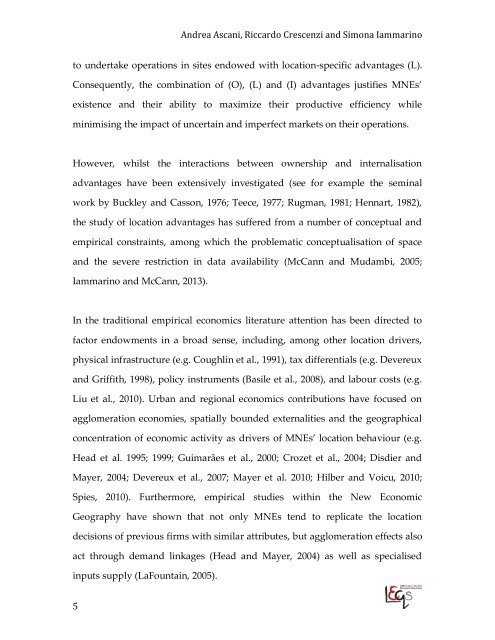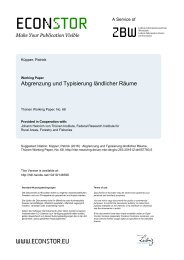their Geographical Neighbourhood
n?u=RePEc:eiq:eileqs:97&r=all
n?u=RePEc:eiq:eileqs:97&r=all
Create successful ePaper yourself
Turn your PDF publications into a flip-book with our unique Google optimized e-Paper software.
Andrea Ascani, Riccardo Crescenzi and Simona Iammarino<br />
to undertake operations in sites endowed with location-specific advantages (L).<br />
Consequently, the combination of (O), (L) and (I) advantages justifies MNEs’<br />
existence and <strong>their</strong> ability to maximize <strong>their</strong> productive efficiency while<br />
minimising the impact of uncertain and imperfect markets on <strong>their</strong> operations.<br />
However, whilst the interactions between ownership and internalisation<br />
advantages have been extensively investigated (see for example the seminal<br />
work by Buckley and Casson, 1976; Teece, 1977; Rugman, 1981; Hennart, 1982),<br />
the study of location advantages has suffered from a number of conceptual and<br />
empirical constraints, among which the problematic conceptualisation of space<br />
and the severe restriction in data availability (McCann and Mudambi, 2005;<br />
Iammarino and McCann, 2013).<br />
In the traditional empirical economics literature attention has been directed to<br />
factor endowments in a broad sense, including, among other location drivers,<br />
physical infrastructure (e.g. Coughlin et al., 1991), tax differentials (e.g. Devereux<br />
and Griffith, 1998), policy instruments (Basile et al., 2008), and labour costs (e.g.<br />
Liu et al., 2010). Urban and regional economics contributions have focused on<br />
agglomeration economies, spatially bounded externalities and the geographical<br />
concentration of economic activity as drivers of MNEs’ location behaviour (e.g.<br />
Head et al. 1995; 1999; Guimarães et al., 2000; Crozet et al., 2004; Disdier and<br />
Mayer, 2004; Devereux et al., 2007; Mayer et al. 2010; Hilber and Voicu, 2010;<br />
Spies, 2010). Furthermore, empirical studies within the New Economic<br />
Geography have shown that not only MNEs tend to replicate the location<br />
decisions of previous firms with similar attributes, but agglomeration effects also<br />
act through demand linkages (Head and Mayer, 2004) as well as specialised<br />
inputs supply (LaFountain, 2005).<br />
5




